
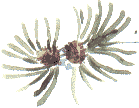 
Nipped in the Bud
Saturday 11th
March 2000




 Nature Diary
Rocks
History
Gallery
Links
Home Page
Nature Diary
Rocks
History
Gallery
Links
Home Page

 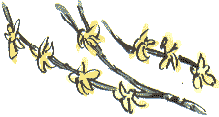
HOUSE SPARROWS feed on the buds of a garden Forsythia. They nip them off, nibble them, then wipe their beaks on the branch.
A walk through the woods
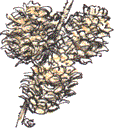 We take an afternoon walk around Haw Park, four miles south-east of Wakefield. This was originally a heathy area but it was planted with Oaks as long ago as 1903 and with Corsican Pine as recently as 1984-5. Most of the conifers were planted by the Forestry Commission between 1946 and 1968.
We take an afternoon walk around Haw Park, four miles south-east of Wakefield. This was originally a heathy area but it was planted with Oaks as long ago as 1903 and with Corsican Pine as recently as 1984-5. Most of the conifers were planted by the Forestry Commission between 1946 and 1968.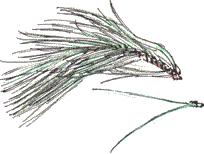 During that period, in the aftermath of the Second World War, the priority was for the country to be self-sufficient in timber, and, as I've mentioned before, there was a steady demand for pit props, which has now disappeared with the change from deep mining to opencast. During that period, in the aftermath of the Second World War, the priority was for the country to be self-sufficient in timber, and, as I've mentioned before, there was a steady demand for pit props, which has now disappeared with the change from deep mining to opencast.
The three cones are those of Japanese Larch, which is still bare of needles, larches being deciduous.
  Dozens of Corsican pine cones lie alongside the path, stripped of their scales, most likely by Grey Squirrels after the seeds. To quote from Roger Phillips' Trees in Britain its 'needles are usually longer than Pinus nigra (Crimean Pine) and are slightly twisted. They are grouped in pairs and arranged rather sparsely on the branches, not in distinct whorls as in P.nigra.' Some day I will sort out the conifers! Look closely and they have, to me, an unfamiliar, almost prehistoric look. The branch I've sketched is covered with prominent scars, like a prehistoric tree.
Dozens of Corsican pine cones lie alongside the path, stripped of their scales, most likely by Grey Squirrels after the seeds. To quote from Roger Phillips' Trees in Britain its 'needles are usually longer than Pinus nigra (Crimean Pine) and are slightly twisted. They are grouped in pairs and arranged rather sparsely on the branches, not in distinct whorls as in P.nigra.' Some day I will sort out the conifers! Look closely and they have, to me, an unfamiliar, almost prehistoric look. The branch I've sketched is covered with prominent scars, like a prehistoric tree.
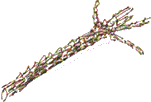 Back home, late afternoon, we disturb a Sparrowhawk that is plucking its prey by the garden shed.
Back home, late afternoon, we disturb a Sparrowhawk that is plucking its prey by the garden shed. 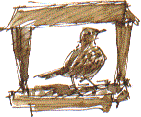 At first sight the feathers look grey, but these are the downy breast feathers. Each one has dark brown tips and there are one or two brown tail or wing feathers amongst them. It was probably a female Blackbird (left) that the sparrowhawk, on its regular patrol, had surprised. At first sight the feathers look grey, but these are the downy breast feathers. Each one has dark brown tips and there are one or two brown tail or wing feathers amongst them. It was probably a female Blackbird (left) that the sparrowhawk, on its regular patrol, had surprised.

Richard Bell,
wildlife illustrator
E-mail; 'richard@daelnet.co.uk'
 Next day
Previous day
Nature Diary
Wild West Yorkshire home page
Next day
Previous day
Nature Diary
Wild West Yorkshire home page

|




 We take an afternoon walk around Haw Park, four miles south-east of Wakefield. This was originally a heathy area but it was planted with Oaks as long ago as 1903 and with Corsican Pine as recently as 1984-5. Most of the conifers were planted by the Forestry Commission between 1946 and 1968.
We take an afternoon walk around Haw Park, four miles south-east of Wakefield. This was originally a heathy area but it was planted with Oaks as long ago as 1903 and with Corsican Pine as recently as 1984-5. Most of the conifers were planted by the Forestry Commission between 1946 and 1968. During that period, in the aftermath of the Second World War, the priority was for the country to be self-sufficient in timber, and, as I've mentioned before, there was a steady demand for pit props, which has now disappeared with the change from deep mining to opencast.
During that period, in the aftermath of the Second World War, the priority was for the country to be self-sufficient in timber, and, as I've mentioned before, there was a steady demand for pit props, which has now disappeared with the change from deep mining to opencast. Dozens of Corsican pine cones lie alongside the path, stripped of their scales, most likely by Grey Squirrels after the seeds. To quote from Roger Phillips' Trees in Britain its 'needles are usually longer than Pinus nigra (Crimean Pine) and are slightly twisted. They are grouped in pairs and arranged rather sparsely on the branches, not in distinct whorls as in P.nigra.' Some day I will sort out the conifers! Look closely and they have, to me, an unfamiliar, almost prehistoric look. The branch I've sketched is covered with prominent scars, like a prehistoric tree.
Dozens of Corsican pine cones lie alongside the path, stripped of their scales, most likely by Grey Squirrels after the seeds. To quote from Roger Phillips' Trees in Britain its 'needles are usually longer than Pinus nigra (Crimean Pine) and are slightly twisted. They are grouped in pairs and arranged rather sparsely on the branches, not in distinct whorls as in P.nigra.' Some day I will sort out the conifers! Look closely and they have, to me, an unfamiliar, almost prehistoric look. The branch I've sketched is covered with prominent scars, like a prehistoric tree. Back home, late afternoon, we disturb a Sparrowhawk that is plucking its prey by the garden shed.
Back home, late afternoon, we disturb a Sparrowhawk that is plucking its prey by the garden shed.  At first sight the feathers look grey, but these are the downy breast feathers. Each one has dark brown tips and there are one or two brown tail or wing feathers amongst them. It was probably a female Blackbird (left) that the sparrowhawk, on its regular patrol, had surprised.
At first sight the feathers look grey, but these are the downy breast feathers. Each one has dark brown tips and there are one or two brown tail or wing feathers amongst them. It was probably a female Blackbird (left) that the sparrowhawk, on its regular patrol, had surprised.